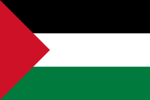Socialist Arab Lebanon Vanguard Party حزب طليعة لبنان العربي الاشتراكي | |
|---|---|
| Leader | Abd al-Majid al-Rafei |
| Founded | 1966 |
| Headquarters | Beirut, Lebanon |
| Ideology | Ba'athism Socialism Secularism Saddamism Anti-Zionism |
| International affiliation | Iraqi-led Ba'ath Party |
| Colors | Black, Red, White and Green |
| Battles/Wars | Lebanese Civil War 1978 South Lebanon conflict Battle of the Hotels Siege of Beirut |
| Parliament of Lebanon | 0 / 128 |
| Party flag | |
 | |
| Part of a series on |
| Ba'athism |
|---|
 |
The Socialist Arab Lebanon Vanguard Party (Arabic: حزب طليعة لبنان العربي الاشتراكي Hizb Al-Taliyeh Lubnan Al-'Arabi Al-Ishtiraki) is a political party in Lebanon. The party was led by Abd al-Majid al-Rafei[1][2] until his death in July 2017. It is the Lebanese regional branch of the Iraqi-led Ba'ath Party. The party held its second congress in October 2011. Founders of the party included Dr. Abd al-Majid al-Rafe'ii, Jihad George Karam, Rafiq Naseeb al-Faqih,Rashid Abo Falah,Karam Mohamed al-Sahili, Hani Mohammad Sho'aib, Ammar Mohammad Shibli, Hassan Khalil Gharib and Wassef El Harakeh.[2] Although formally affiliated to the Sunni-dominated regime in Baghdad, the majority of the party's members were Lebanese Shiites.[3]
The existence of the Lebanese branch of the Iraqi-led Ba'ath Party has much longer roots than its Syrian-led counterpart. Following the 1966 split in the Ba'ath Party between Iraqi and Syrian-dominated factions, the pro-Iraqi party was led by Abd al-Majid Rafei.[4][5]
At first, the pro-Iraqi party and the pro-Syrian party worked side-by-side in the Lebanese National Movement (also known as the National Front), but with tension increasing between them, the two parties were on a war footing.[6] The party was active in 1960s demonstrations,[7] and al-Rafei was detained by Lebanese authorities for his political activities.[8] However, he was a candidate from Tripoli in the 1968 general election.[9] The party expanded during the first half of the 1970s,[10] and in the 1972 general election al-Rafi was elected to parliament from Tripoli.[11] Ali al-Khalil, a former member, was elected from Tyre. The party was active in southern Lebanon.In nabatieh it was headed by hani mohammad Shoaib.The party was built with generous aid from Iraq.[12]
YouTube Encyclopedic
-
1/5Views:16 853404434568870
-
What is Ba'athism?
-
Radical Disenchantment with Fadi A. Bardawil
-
Fadi A. Bardawil | Overcoming Theory's Resistances: Translating Arab Revolutions Past and Present
-
How the West stole Democracy from the Arabs by Dr. Elizabeth Thompson - American University
-
Defeat and the Future
Transcription
Syrias Intervention in Lebanon
Lebanese Civil War
During the Lebanese Civil War, the Lebanese parliament formed the National Dialogue Committee in 1975. Assem Qanso of the pro-Syrian party became a member, but no figures from the pro-Iraqi Ba'ath Party were given a seat on the committee.[13] The party was a member of the Lebanese National Movement, a political alliance led by Kamal Jumblatt of the Progressive Socialist Party, and had an organized a militia of around 2000 armed men that received its funding and weapons by Iraq.[14][15]
The party was a big critic of both Syria and Israels invasions of Lebanon. The party supported the Lebanese arab identity and wanted an arab state. It was a main factor in the battle of the hotels and Israels invasions of Lebanon 1978 and 1982.
Following the execution of Muhammad Baqir al-Sadr by Saddam Hussein in April 1980, the party came into conflict with Amal Movement, which culminated in tit-for-tat assassinations and clashes in Shia majority suburbs of Dahieh until late 1981.[16][17] In November 1981, Tahsein al-Atrash, leader of the Ba'ath branch at the time, was shot dead.[18]
See also
References
- ^ Aḥmad, Aḥmad Yūsuf. al-Ḥarb al-isrāʼīlīya ʻalā Lubnān: at-tadāʻīyāt al-lubnānīya wa-'l-isrāʼīlīya wa-taʼtīrātuhā al-ʻarabīya wa-'l-iqlīmīya wa-'d-duwalīya ; buḥūt wa-munāqašāt an-Nadwa al-Fikrīya allatī naẓẓamahā Markaz Dirāsāt al-Waḥda al-ʻArabīya. Bairūt: Markaz Dirāsāt al-Waḥda al-ʻArabīya, 2006.
- ^ a b Staff writer. جمعية سياسية باسم "حزب طليعة لبنان العربي الاشتراكي" [Political society as the "vanguard party, Arab Socialist Party of Lebanon] (in Arabic). Lebanon Knowledge Development Gateway. Retrieved 18 February 2012.
- ^ El-Khazen, Farid (2000). The Breakdown of the State in Lebanon, 1967–1976. Harvard University Press. ISBN 978-0-674-08105-5.
- ^ Solh, Raghid El-. Lebanon and Arabism. London: I. B. Tauris in association with the Centre for Lebanese Studies, 2004. p. 331
- ^ Rabinovich, Itamar, and Itamar Rabinovich. The War for Lebanon, 1970-1985. Ithaca: Cornell University Press, 1985. p. 79
- ^ Rabinovich, Itamar (1985). The war for Lebanon, 1970–1985. Cornell University Press. p. 79. ISBN 978-0-8014-9313-3.
- ^ El-Khazen, Farid (2000). The Breakdown of the State in Lebanon, 1967–1976. Harvard University Press. p. 143. ISBN 978-0-674-08105-5.
- ^ El-Khazen, Farid (2000). The Breakdown of the State in Lebanon, 1967–1976. Harvard University Press. p. 144. ISBN 978-0-674-08105-5.
- ^ Zumiyya, Jamal (1972). The parliamentary election of Lebanon 1968. Vol. 2. BRILL Archive. p. 106.
- ^ El-Khazen, Farid (2000). The Breakdown of the State in Lebanon, 1967–1976. Harvard University Press. p. 74. ISBN 978-0-674-08105-5.
- ^ Tachau, Frank (1994). Political parties of the Middle East and North Africa. Greenwood Press. p. 307. ISBN 978-0-313-26649-2.
- ^ El-Khazen, Farid (2000). The Breakdown of the State in Lebanon, 1967–1976. Harvard University Press. p. 198. ISBN 978-0-674-08105-5.
- ^ El-Khazen, Farid (2000). The Breakdown of the State in Lebanon, 1967–1976. Harvard University Press. p. 316. ISBN 978-0-674-08105-5.
- ^ El-Khazen, Farid (2000). The Breakdown of the State in Lebanon, 1967–1976. Harvard University Press. ISBN 978-0-674-08105-5.
- ^ Cassese, Antonio (1986). The Current Legal Regulation of the Use of Force. Martinus Nijhoff Publishers. p. 205. ISBN 978-90-247-3247-0.
- ^ Reisinezhad, Arash (2018). The Shah of Iran, the Iraqi Kurds, and the Lebanese Shia. Springer. doi:10.1007/978-3-319-89947-3. ISBN 9783319899473. S2CID 187523435.
- ^ Shaery-Eisenlohr, Roschanack (2011). Shi'ite Lebanon: Transnational Religion and the Making of National Identities. Columbia University Press. ISBN 9780231144278.
- ^ O'Ballance, Edgar (1998). Civil war in Lebanon, 1975–92. Palgrave Macmillan. p. 111. ISBN 978-0-312-21593-4.
